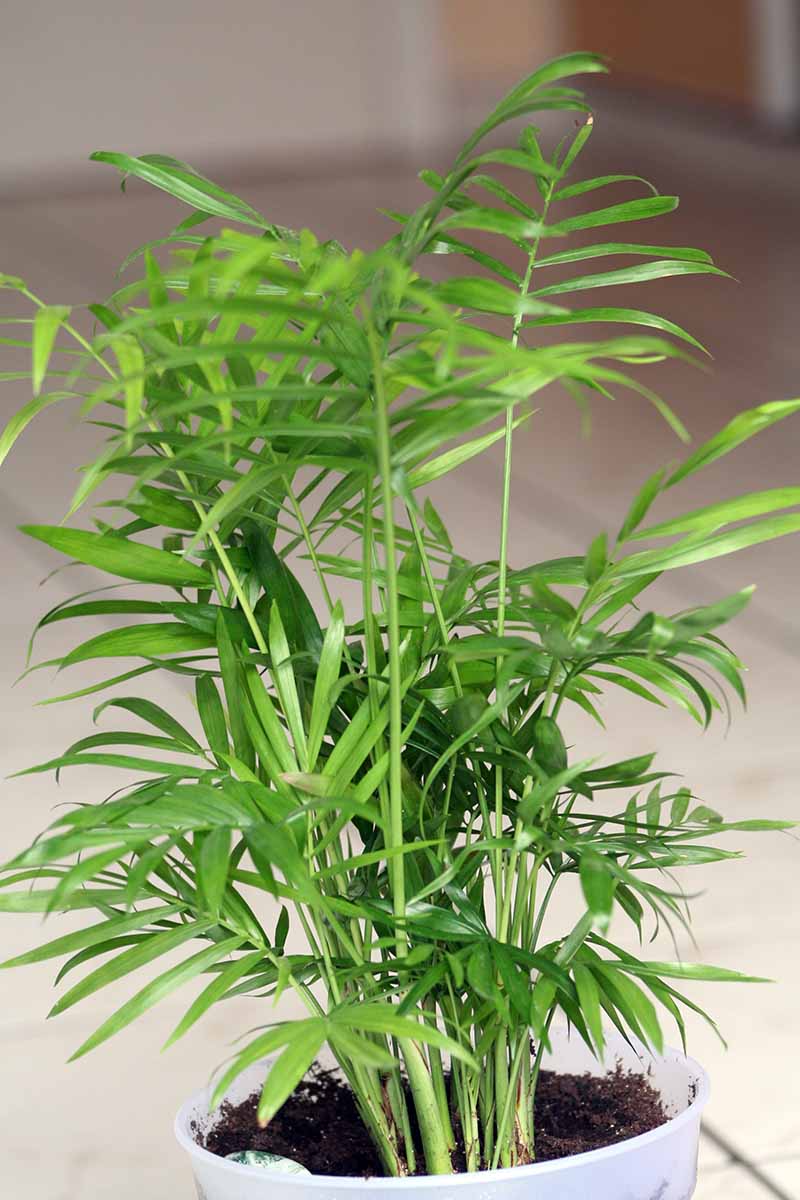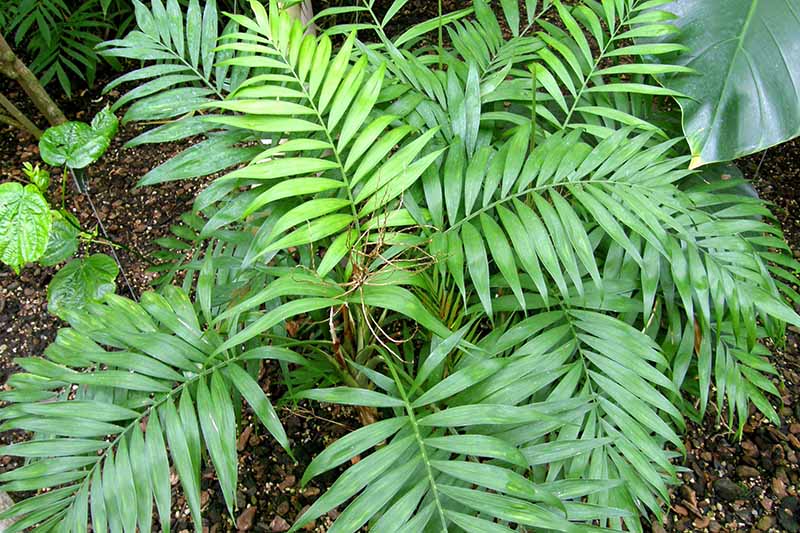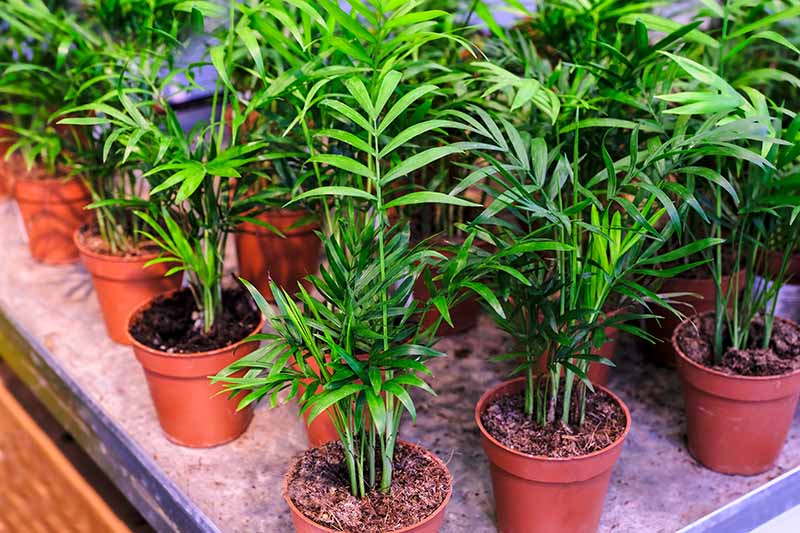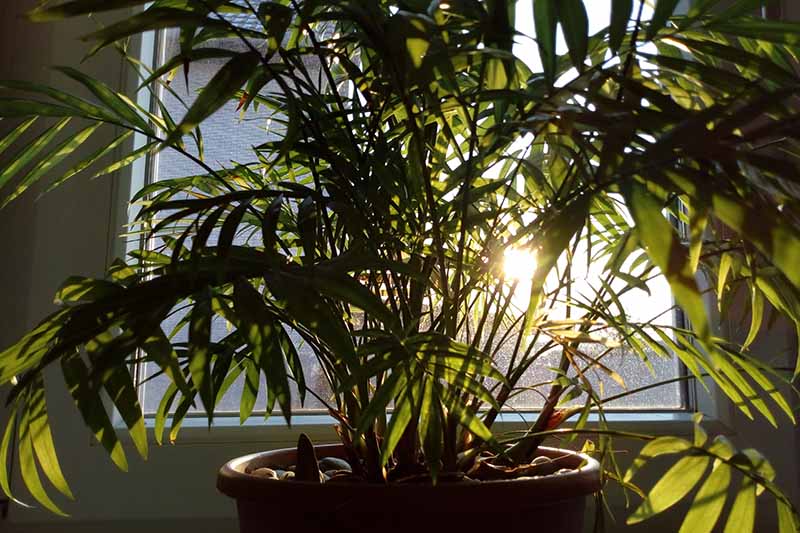Chamaedorea elegans
Parlor palms have a long history as houseplants – and not without reason.
These plants add lush green foliage to our households, can adapt to a variety of conditions, and are supremely easy to care for. They make the perfect plant companions for houseplant newbies!
In fact, there are few other houseplants that are as easy to care for and flexible in their care needs as these trees. And many of the notable exceptions, such as sansevieria and pothos, are toxic if ingested by pets or children.
Parlor palm, on the other hand, is just as easy to care for as the famously easygoing snake plant and devil’s ivy, but it comes with the added bonus of being nontoxic – a feature important to those of us with young kids or fur babies in our households.

We link to vendors to help you find relevant products. If you buy from one of our links, we may earn a commission.
Of course, it’s also a simply lovely houseplant! And it will add a slightly tropical vibe to your living space.
I’m going to fill you in on everything you’ll need to know about growing this tree as a houseplant – and then you can let the green fronds of this small tree fill as many corners of your home as you like!
Here’s what we’ll cover:
What Are Parlor Palms?
The parlor palm, Chamaedorea elegans, is a type of small understory tree that is native to tropical and subtropical rainforests in Belize, Guatemala, Honduras, and Mexico.
In the wild, it grows in lowland and mountain forests that have moist, wet, or mixed climates.

Here are some tips for recognizing this species when compared to other indoor palms:
This tree has fronds that are pinnately compound, meaning its leaves are divided into many leaflets, emerging from either side of the leaf stem, rather like a feather. Many ferns have pinnately compound leaves as well.
The fronds of C. elegans grow from a single, unbranched trunk. If your parlor palm has many trunks arising from the soil, be aware that specimens sold as houseplants often have several individual plants growing in the same pot to create a fuller appearance.
The evergreen foliage is a medium green color. Leaflets are lance-shaped with smooth margins, and they grow to be four to eight inches long and less than an inch wide.
The fronds of C. elegans have an arching or drooping appearance.

This tree has an upright, open growth habit, usually reaching a height of up to eight feet at most when grown indoors. But don’t worry, it is a slow grower and will take many years to reach such a tall stature inside your home.
Outdoors, it can reach 10 feet tall.
Though you may not experience this plant’s flowering and fruiting cycle when it’s kept as an indoor houseplant, C. elegans produces small yellow flowers.

The female flowers are rounded and have no petals, while the male flowers are even smaller than the female ones, and they are yellow and green. The flowers bloom from late winter to early spring.
If pollinated, the flowers are followed by black fruits containing seeds, which can be used to propagate new trees. When the fruits ripen, the flower stems will turn reddish orange.
However, male and female flowers are produced on separate plants, so if you’re hoping to grow your own supply of seeds, you’ll need to obtain plants of both sexes. If your houseplant is actually a clump of several individuals, you may have both genders available already!

Parlor palms are part of the Arecaceae or palm family, meaning these houseplants are relatives of the loftier coconut trees, date palms, and palmetto trees.
Within this larger family, the subject of our article belongs to the genus Chamaedorea, which is made up entirely of understory palm trees.
Other members of the Chamaedorea genus include the cat palm (C. cataractarum), metal palm (C. metallica), hardy bamboo palm (C. microspadix), and pacaya palm (C. tepejilote).
Cultivation and History
The genus name Chamaedorea comes from two Greek words meaning “low” and “gift,” while the species name elegans means “elegant.”
This “elegant and low gift” gets its common name (alternately spelled “parlour palm”) from the Victorian days when it was grown in English living rooms.

In addition to its most well-known moniker, this plant is also known as “dwarf palm,” “dwarf mountain palm,” “fish tail dwarf palm,” “good luck palm,” “reed palm,” and “neanthe palm.”
As for its botanical name, there are also a couple of synonyms that you may come across: Neanthe bella and Collinia elegans.
Like many species of flora, the subject of our article has more than one scientific name in use because it was described by more than one scientist at different times, but C. elegans is widely agreed to be the “official” name for this species.
The name “neanthe bella” is also sometimes used as a common name.

In its native habitat, C. elegans is one of three species harvested for cut fronds, known as xate (pronounced SHA-tay).
These fronds, used in the floral industry and for religious ceremonies, are valued for their long lasting greenery – they keep for up to forty-five days after cutting!
And while these plants are commonly grown indoors as houseplants, they can also be grown outdoors year-round in USDA Hardiness Zones 10b to 11.
Propagation
There’s only one method of propagation to use for growing new specimens of C.elegans – propagation from seed.
Don’t bother trying to propagate parlor palms by rooting a cutting – this method won’t work.
And since this species has only a single trunk, it can’t be divided.
But you may be wondering, what if your houseplant is a clump of many individual plants? Can you separate these from each other? Although this method works for houseplants such as Norfolk Island pine, the subject of our article does not respond well to this type of operation.

That leaves us with no other choice than to grow this species from seed – and in fact, propagation by seed is precisely how nurseries grow these tropical trees!
You can learn how to grow your own parlor palm houseplants from seed in our step-by-step guide. (coming soon!)
How to Grow
Although this species is known for being easy to care for, here are some tips to keep your houseplant at its happiest.
Choosing a Specimen
If you’re hoping to start a long-term relationship with this tropical tree, be sure to start with a healthy specimen.
Choose a plant that is free from yellow or brown leaves, and that is perky rather than wilting.
Also check the specimen’s pot and make sure it has drainage holes in it.

And before you buy, look for signs of insects or disease. Scale insects in particular can be easy to overlook on these plants unless you know what you’re looking for.
You’ll learn more about inspecting this plant for pests and signs of disease later in the article, so keep reading.
Light
These trees grow best in indirect, medium light, but they can also tolerate bright or low light conditions.
However, you’ll want to avoid direct sunlight, which will cause the leaves to scorch.

And if you decide to place your houseplant outdoors during the warm summer months, make sure to situate it in the shade where only dappled light will dance across its leaves.
Temperature
Being from regions with subtropical and tropical climates, these plants are most comfortable in a temperature range between 60 and 85°F. However, they will tolerate cooler conditions down to 50°F.

So, considering its flexible light and temperature needs, if you are looking for a houseplant for a cool room on the north side of your home, this tree would make an excellent candidate.
Water
When the weather is warm, your good luck palm will need to be watered approximately once a week – it likes to have moist soil.
However, in the winter, you can let the top two inches or so of the soil dry out in between waterings. This means in winter, you’ll likely water less frequently, perhaps once every ten days to two weeks.

Keep in mind that although this plant appreciates moist soil, it also needs good drainage – don’t let its soil get soggy or waterlogged.
The chore of watering will be much easier if you choose the right type of watering can, so make sure you check out our roundup of nine of the best watering cans for houseplants!
Humidity
Hailing, as I’ve mentioned, from parts of the world with tropical and subtropical climates, this species prefers higher humidity – however, it will adapt to drier air.
According to the North Carolina State University Extension staff, these plants appreciate having their foliage misted to increase humidity levels.

There’s another way to add moisture to the air for your tree – consider grouping it together with other houseplants.
A grouping of houseplants will create a microclimate where the relative humidity is slightly higher than it is elsewhere in your home.
These methods will be particularly helpful during the winter when the indoor air is dry due to heating.
Growing Tips
- Provide medium, indirect light.
- Avoid exposure to direct sunlight.
- Keep soil moist but not soggy.
Pruning and Maintenance
Maintaining your parlor palm is fairly simple and straightforward. Here’s what you need to know:
Pruning
The lower leaves on this tropical species turn brown with age. To keep your specimen looking tip-top you might want to prune those back – or simply throw them in your compost bin after they fall off.
Leaflet tips may also turn brown, and these can be trimmed back.

Before pruning your plant’s leaves, be sure to sterilize your scissors first by wiping them with hydrogen peroxide or rubbing alcohol.
Apart from trimming spent leaves, this species doesn’t require any other pruning.
Repotting
Your neanthe bella won’t need to be repotted very often – only once every two or three years, and only when it’s rootbound.
When it is time to repot, do so during a period of active growth, in the spring or summer.
You’ll also want to make sure to use the right type of potting medium.
These trees prefer soil that is acidic to slightly alkaline, with a pH ranging from 6.1 to 7.8, and it must drain well.
Palms can be grown in the same potting mixes that are used for cacti and succulents; sometimes you’ll find specialized soils designated for all three types of plants.

Tanks’ Pro Organic Cactus and Succulent Mix
My favorite for repotting this houseplant is Tanks’ Pro Organic Cactus and Succulent mix, available in a 16-quart bag via Amazon.
Fertilizing
Palms have specific needs for micronutrients, particularly magnesium, so when you are fertilizing, make sure you choose a product specially designed for these types of plants.
I recommend Dr. Earth’s Organic and Natural Exotic Blend Fertilizer, a type of dry fertilizer that you work into your soil. It’s available in one- or four-pound bags, via Amazon.

Dr. Earth Organic and Natural Exotic Blend Fertilizer
Follow the manufacturer’s instructions for applying this product.
You’ll only need to fertilize your tree two or three times during the growing season – approximately every two months starting in spring.
Cleaning Leaves
Dust can build up on the leaves of your houseplants. To keep this particular species healthy, shy away from using any special leaf-cleaning products, as these can do more harm than good.
Instead, if your houseplant needs a bit of a cleaning, just use water. Depending on its size, place it in the sink or bathtub and give it a shower.

Alternately, you can spritz it with water, then wipe the leaves down with a paper towel or clean rag.
It’s best to do this in the morning so the leaves have time to dry before nightfall.
Where to Buy
When you’re looking for a specimen to buy, you have options when it comes to size. This species grows slowly, so if a large plant is what you really want, start with one!
Here are a few options:
Small
If a small houseplant is what you’re looking for to place at your workstation or to brighten up a shelf, look for a specimen in a four-inch pot or something smaller.

Live C. elegans in 4-inch Pot
You’ll find a petite parlor palm in a four-inch pot available from Hirt’s Gardens Store via Amazon.
Medium
Want a plant that will make an impact on a side table or in an entryway? Choose a specimen that’s growing in a six- or seven-inch pot.

Live C. Elegans in 6-inch Pot
You’ll find a live parlor palm in a six-inch pot available from Fast Growing Trees.
Large
If the plant companion of your dreams is large enough to make an impact sitting on the floor, look for a specimen in an eight-inch pot or something larger.

Live C. Elegans in 10-inch Pot
You’ll find a live plant for purchase in a 10-inch pot from Wekiva Foliage via Amazon.
Managing Pests and Disease
These houseplants aren’t particularly prone to pests or diseases, but you’ll want to know what to look out for. Keep your eyes peeled for the following.
Insects
If your tree spends its summers outdoors (in a well-shaded location, of course), you may find that a pest or two has taken up residence when it is time to bring it back indoors.
Also, sometimes new specimens arrive with not-so-welcome stowaways. Here are some of the most common pests you might encounter:
Mealybugs
Mealybugs are one of the most common pests to reside on our houseplants. Easily overlooked by the untrained eye, mealybugs can look like bits of white fluff stuck to the stems of your plant.

Along with gathering on stems, they also like to congregate on the undersides of leaves.
These pesky insects will suck nutrients from your houseplant, weakening it.
As if that wasn’t enough, they produce sticky honeydew which can encourage the growth of fungal pathogens on your plant as well.
You have many options when dealing with a mealybug infestation. You can learn more about handling these pests in our complete guide to identifying and controlling mealybugs.
Scale
Scale is another common houseplant pest, and it can be particularly hard to spot on palm trees.
These insects might be mistaken for brown spots on the stems – but under their dome-shaped shells they are busy stealing nutrients from your houseplant.

These insects like to hunker down on leaf undersides as well as on stems.
To learn more about managing a scale infestation, read our article on the topic.
Spider Mites
Have you noticed pale spots on the leaves of your tree? Inspect it closely, because you may have spider mites.
Once an infestation becomes full-blown, you will probably notice fine webbing draped around your plant’s foliage as well.

These are the signs of tiny and harmful spider mites which, like mealybugs and scale insects, are all to happy to suck nutrients from your houseplant.
If left unchecked, your tree will start to drop its leaves, and will eventually die from the damage inflicted by these pests.
Read our article to learn how to inspect your houseplants for spider mites and manage an infestation.
Disease
Here are some diseases to be aware of that could affect your tree:
Damping Off
When propagating new parlor palm specimens from seed, damping off is a threat you’ll want to be aware of, especially since it can be prevented.
This fungal disease can affect young seedlings, and unfortunately, by the time you notice there’s a problem, it’s usually too late. Since there is no treatment for an afflicted seedling, prevention is imperative.
Learn more about damping off and how to prevent it in our complete guide.
Leaf Spot
Have you noticed irregular gray or tan spots surrounded by yellow halos on your tree’s foliage? Your houseplant may be suffering from leaf spot disease.
Leaf spot may be caused by various fungal organisms and water molds. There’s one in particular that targets parlor palms – this oomycete is called Phytophthora palmivora.
Among houseplants, these organisms are most likely to be transmitted through unsanitized growing supplies, so make sure to always start with clean garden tools and pots.
If this disease appears in one of your houseplants, it’s best to dispose of the plant to avoid further spread.
Root Rot
Root rot can occur when soil conditions remain too soggy for too long. Lacking the necessary oxygen, your plant’s roots can start to decay, preventing them from taking up water. This can lead to a sad and somewhat ironic death by dehydration.
Like damping off, root rot is another houseplant disease for which the best treatment is prevention. Namely, you must prevent yourself from overwatering your beloved potted friends.
Other potential causes of this disease include poor drainage, poor drainage, and poor drainage. Shall I say that again? Beware the dreaded poor drainage!
What causes poor drainage? A potting medium designed for high water retention, for one thing. So make sure your specimen is planted in an appropriate potting medium such as the one described previously, in the potting section above.
Another potential cause is a pot that is too large for your plant. In oversized pots, soil can remain soggy for too long, since the plant’s roots are unable to take up all of the available water.
But the absolute poorest drainage condition of all is one with no drainage whatsoever. That’s right, folks – I’m talking about pots with no holes in the bottom.
If your dear palm is potted in a container where water cannot drain through the bottom, all I can say is, please return to the repotting section above and remedy the situation as soon as possible.
Best Uses
As mentioned, the parlor palm has a long and successful history as a houseplant thanks to its easygoing nature.
It will, as its name suggests, look fine and dandy in your living room or sitting room – or most anywhere else in your home when it’s used as an accent plant for its verdant foliage.
It can also be used in indoor public spaces such as office buildings or medical offices, as part of an interiorscape.

And since this species is nontoxic, it is safe for use in households with curious pets and young children.
Not only is it safe to keep this plant in your home, this tree may also help improve your indoor air quality. In certain conditions, C. elegans can help to remove indoor air pollutants such as formaldehyde.
And in addition to its use as a houseplant, those who live in USDA Hardiness Zones 10b to 11 can also enjoy this species in the outdoor landscape, where it can be grown in shady conditions year-round.
Quick Reference Growing Guide
| Plant Type: | Evergreen understory tree | Foliage Color: | Yellow (rare indoors)/green |
| Native to: | Belize, Guatemala, Honduras, Mexico | Tolerance: | Humidity, drought, low light |
| Hardiness (USDA Zone): | 10b-11 | Soil Type: | Cactus, succulent, and palm potting mix |
| Bloom Time/Season: | Late winter to early spring (usually only when grown outdoors) | Soil pH: | 6.1-7.8 |
| Exposure: | Medium indirect light | Soil Drainage: | Well-draining |
| Time to Maturity: | Several years | Uses: | Ornamental houseplant; interiorscaping |
| Height: | 8 feet | Order: | Arecales |
| Spread: | 2-3 feet | Family: | Arecaceae |
| Water Needs: | Medium | Genus: | Chamaedorea |
| Maintenance: | Low | Species: | Elegans |
| Common Pests: | Beetles, fungus gnats, mealybugs, mites, nematodes, scale, shore flies, spider mites, thrips | Common Diseases: | Bud rot, damping off, false smut, Ganoderma butt rot (basal stem rot), Gliocladium stem blight, leaf spot, root rot |
Have No Qualms, You Can Grow these Palms
If you were nervous about growing this plant before you started reading, I hope your mind is now at ease.
You should now know just how easy it is to keep your parlor palm houseplant looking fresh and verdant for years to come.

What drew you to growing this frond-filled tree? Its ease of care? Its tropical vibe? Or its worry-free status as a nontoxic species?
Whatever the reason, you’ve made an excellent choice in embarking on this adventure with a parlor palm. Let us know how you’re enjoying your plant companion in the comments section below.
If you need to brush up on your houseplant care basics, you’ll want to read our primer for growing durable plants.
And if you’re interested in learning about other palm trees you can grow indoors, give these articles a read next:











